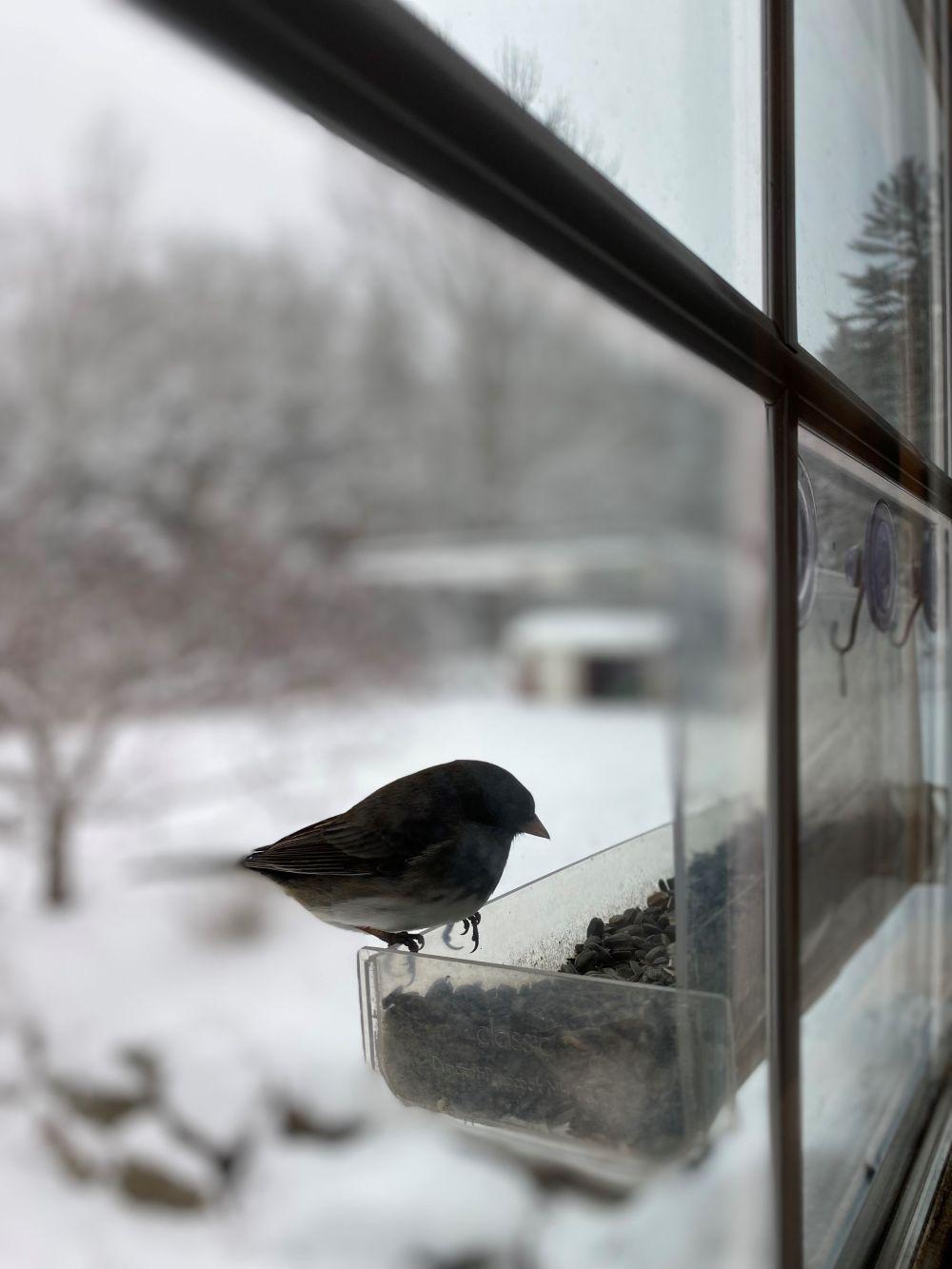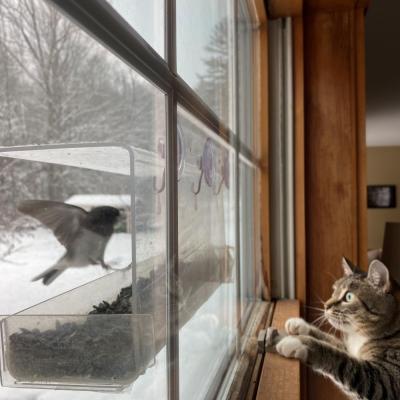Feeding birds connects me to larger questions and brings wildlife right to the window in winter.
- Tags:
- Education,
- Something Wild

Dark eyed junco is among the most common winter feeder birds in January. The top ten list includes the familiar and successful winter residents. (Photo: Dave Anderson)
Hope Is The Thing With Feathers - Emily Dickinson
“Hope is the thing with feathers –
That perches in the soul –
And sings the tune without the words –
And never stops – at all…”
Birds are indeed little emissaries of hope — this is particularly true in winter when the sun won’t shine. Yet birds arrive faithfully bringing news from realms beyond human endeavors. I enjoy walking from window to window with a cup of coffee at sunrise to watch the arrival of familiar feeder birds. Despite bitter arctic temperatures and potential for snowstorms in January, a subtle increase in sunlight triggers a response by songbirds: early morning tweets and twitters are on the uptick with fragments of spring songs audible before February. It has already begun.
Bird feeding is also therapy: mental wellness. Watching wild birds delivers animation, color and anticipation of springtime. Hardy resident songbirds and drumming woodpeckers telegraph faith in what lies ahead. The most common birds at backyard feeders are most successful: they have adapted to life in the woods or suburbs during the lean months of the year. Each species has unique family traits or peculiar habits and feeding preferences.
My “Top Ten” list for the most common birds at our sunflower seed and suet feeders are consistent from winter to winter.
The daily list in order of decreasing frequency includes Dark-eyed Junco, Black Capped Chickadee, Tufted Titmouse and White-Breasted Nuthatch. These four species in shades of black, white or gray are the most common and consistent. The next two species are less predictable: Red-Breasted Nuthatch and American Goldfinch. Two larger, more colorful visitors are Blue Jay and Cardinal. The Top Ten list is complete with two woodpeckers: smaller Downy Woodpecker (size of a Titmouse) and larger, Hairy Woodpecker (size of a Blue Jay).

The total birdfeeder list this winter is roughly 16 species. The next three in decreasing order of frequency are common yet irregular feeder visitors: Red-Bellied Woodpecker, Mourning Dove and Bluebird. Three relative rarities this winter so far are Carolina Wren, a lingering pair of Song Sparrows and a recent flock of sleek Cedar Waxwings to round out the list of 16 species visiting since December. Technically, I should also add Wild Turkeys as they are occasional visitors, marching out of surrounding woods to clean-up spilled seed beneath feeders.
What I have NOT seen this winter are the wide-wandering migrants including Pine Siskin, Evening Grosbeak, Purple Finch, Common Redpoll and a specialized conifer cone specialist, the Red-Winged Crossbill.
The annual winter finch forecast (yes there IS such a thing) predicted we would not see Canadians visitors due to ample availability of Pine, Spruce and Balsam Fir cone seeds and strong crops of tiny seeds of aspen, birch and alder that fuel these birds’ wide winter wandering as “facultative migrants.”
In birding terms, this winter is NOT an “irruptive species” year in New England to expect to see northern finches due to strong seed crops across eastern and central Canada and northern Great Lakes States.
Until recently, we didn’t host any fruit-eating birds, “frugivores” that dine on dried crabapples or fruits of wetland shrubs such as wild raisin or winterberry holly. During mild winters, over- wintering Robins and Cedar Waxwings stay in NH wherever fruit remains available on trees, particularly in the warmer SE and Seacoast regions. This past week, a first flock of Cedar Waxwings arrived with our local flock of Bluebirds before the cold snap. Birds sense severe weather. The waxwings sampled the crabapple supply only briefly. We have enjoyed a small flock of bluebirds this winter. More dedicated homeowners maintain tray feeders of mealworms specifically for Bluebirds. Here, the local Bluebirds feasted on ornamental lavender-colored fruits of a Japonica shrub — the color combination of blue against purple was spectacular.

Changes in local habitats – farms and forests vs. suburbs and cities also plays a role in winter bird diversity. I’m curious if winter bird ranges are expanding north during the warmer winters of recent years.
For example: is the arrival of Carolina Wren and Red-bellied Woodpecker a response to milder winters? The annual Audubon Christmas bird count data 20 years ago did not report Red-bellied Woodpeckers in NH. I asked Chris Martin, Conservation Biologist at NH Audubon about range expansions. He replied it makes more sense to look at permanent, year-round residents rather than migratory birds:
“Examples depend to some extent on where in the state you are focusing. For example, up north in Pittsburg and Errol, Christmas Bird Counts have only begun to find Wild Turkey flocks (hens w/ young) in the last 15 years. Also up north, there are examples of ‘surprise’ new residents include wintering Red-bellied Woodpeckers and Tufted Titmouse in just the last ten years.
"A mid-state bird that has swelled in numbers overwintering thanks to milder conditions is the Carolina Wren, a vocal species folks might readily recognize by call.” Martin adds “as more temperate vegetation moves in, it can create conditions that will host more Appalachian species. At least one pair of Red-headed Woodpeckers have been breeding in central NH in the last few years, that’s new. Black Vultures (southern species) are appearing with greater frequency. On the other hand, Merlins and Ravens (northern species) have both been expanding south — so go figure!”
"Get out of here you dang squirrels!"
Lastly — shaking my fist — Gray squirrels at feeders put a dent in the sunflower seed supply. They can’t reach a high tray feeder attached to outside of a window — but I can tell they’re thinking about it. Squirrels arrive to hang and swing inverted from feeders during mid-day when temperatures are typically warmest. Language to describe them isn’t appropriate for a family-friendly feature. At least the juncos gather what the gray squirrels spill.

Fifteen Feathered Friends Family Traits:
- Dark-eyed Junco – The “snowbirds” prefer feeding on the ground but can stand inside a tray feeder but not perched. Emit cheerful little notes when feeding in a flock that sound like “tic tic” or “two two.” Two-tone gray back over white belly. A Frenchman told me he called them: “Le Nunette” the “Little Nun.”
- Black Capped Chickadee- Unsinkable, gregarious, curious, intelligent and tough. Chickadees are present year-round. They visit feeders constantly and perch nearby as I refill their favorite tube feeder. Their diagnostic call “dee-dee-deet” notes are repeated longer when alarmed. A cheerful two-note, spring song begins on warm days in mid-winter. They nest in soft, punky center of dead tree cavities. Visit the winter feeder location in summer to show off offspring. I feel emotional connection to Chickadees.
- Tufted Titmouse – Distinctive large black eye with jaunty, gray crest of feathers on head. Often a rasping-scolding call. Spring song on late winter mornings is “Peter-peter.” Like chickadee flock, an individual pecking order is apparent at feeders. Titmice squabble with unrelated birds. They transport seeds to cache locations nearby and return often for more
- White-breasted Nuthatch – Long slender bill and black cap (like chickadee). Call is a nasal “yank-yank.” Nuthatches are acrobats – they hang inverted, suspended from suet feeders and descend tree trunks upside down in spiral fashion. White breasted nuthatch seems like a cross between chickadee and woodpecker. They toss seeds randomly to get at particularly fat sunflower seed and then leave to cache seeds in tree bark crevices to consume later.
- Red Breasted Nuthatch – Smaller than its white-breasted cousin. Red-breasted nuthatch prefers higher percentage of dense conifer forest habitat; found more commonly near hemlock, spruce and fir. Animated and spend more time upside down than any other non-woodpecker. A very nasal call note. Bold enough to stay on feeder when I approach.
- American Goldfinch – Typically in flocks and often picking grit from dirt road. Skittish and take rapid flight at perceived threat and return to feed occasionally during day but not a constant presence. They toss seeds to get at fattest ones. Their call note is rising whine like up-speak, a question. In flight a “per-chik-o-ree” I think sounds more like “potato chip!” The yellow color is drab greenish – almost gray - in winter and becomes vivid shade of canary yellow, black and white as they molt in late winter.
- Blue Jay – Often described as “bullies.” Jays are large, brash, animated and loud. Jays consume 20-30 seeds at once to store in their “crop” and leave to cache seeds in hidden locations nearby to consume later. I leave dead mice from snap-traps for Blue Jays who carry them off and and stash the carrion. Jays are not subtle. Extremely intelligent and observant, arriving first when feeders are re-filled by watching for chickadee activity.
- Cardinal – “Class Couple” – typically we see a pair: male and a female. Very skittish. Also feed on the ground or in tray feeder but not while perched at a tube feeder. Male is THE most spectacular winter bird particularly posed against a snowy backdrop. Spring song is melodious, outrageous series of repeated phrases and notes beginning with a loud “cheer-cheer.” A crested head – like tufted titmouse and blue jay.
- Downy Woodpecker – Most common. Small size version. Acrobatic. Less skittish and dedicated fan of suet cage. Males more red than females.
- Hairy Woodpecker – Less common. Large size version. Awkard at suet cage, outsized on hanging feeder. More skittish and often solitary. Males more red than females.
- Red-bellied Woodpecker – Relatively “new” to central and northern NH in winter. Would be called “red headed” but name was already taken. A checkered pattern on gray back. Loud calls. In spring, a buzzy “chirrrr-chirrr” call. Males sport bright red mullet hairstyle extending down back of neck; females less – mohawk of red plumage on head.
- Mourning Dove – Occasional visitors. Feed on the ground and often paired. More common in more suburban area, dense houses in the village nearby. When they flush they have a whinny call as they take flight. First dove songs in spring morning chorus is joyful milestone.
- Bluebird- Almost magical. Appear occasionally in small family flocks and may be absent for several weeks at a time. Males dark indigo blue over rusty buff breast. Often perch along telephone wires. Visit bluebird boxes at edge of a frozen pasture to speculate on spring real estate potential.
- Carolina Wren – Another recent arrival now becoming more common. Curved bill and upward tilted stubby tail. Conspicuous black eye line flanked by white. Overall body color in shades of rich red-brown and lighter mocha breast. Animated, restless. Fly under porch roof to glean insects larvae or probe paper hornet nests.
- Cedar Waxwings – Unpredictable and irregular arrivals. Sleek olive green with swept-back crest and black head accents. Wing tips and tail tips waxy yellow and red. Always in a flock and drawn to overwintering fruits, particularly crab apples.
Dave Anderson is the senior director of education for the Forest Society.
